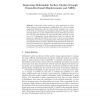Free Online Productivity Tools
i2Speak
i2Symbol
i2OCR
iTex2Img
iWeb2Print
iWeb2Shot
i2Type
iPdf2Split
iPdf2Merge
i2Bopomofo
i2Arabic
i2Style
i2Image
i2PDF
iLatex2Rtf
Sci2ools
MICCAI
2010
Springer
2010
Springer
Improving Deformable Surface Meshes through Omni-Directional Displacements and MRFs
Abstract. Deformable surface models are often represented as triangular meshes in image segmentation applications. For a fast and easily regularized deformation onto the target object boundary, the vertices of the mesh are commonly moved along line segments (typically surface normals). However, in case of high mesh curvature, these lines may intersect with the target boundary at "non-corresponding" positions, or even not at all. Consequently, certain deformations cannot be achieved. We propose an approach that allows each vertex to move not only along a line segment, but within a surrounding sphere. We achieve globally regularized deformations via Markov Random Field optimization. We demonstrate the potential of our approach with experiments on synthetic data, as well as an evaluation on 2x106 coronoid processes of the mandible in Cone-Beam CTs, and 56 coccyxes (tailbones) in low-resolution CTs.
Deformable Surface Models | Line Segment | Medical Imaging | MICCAI 2010 | Regularized Deformations |
| Added | 14 Feb 2011 |
| Updated | 14 Feb 2011 |
| Type | Journal |
| Year | 2010 |
| Where | MICCAI |
| Authors | Dagmar Kainmueller, Hans Lamecker, Heiko Seim, Stefan Zachow, Hans-Christian Hege |
Comments (0)

